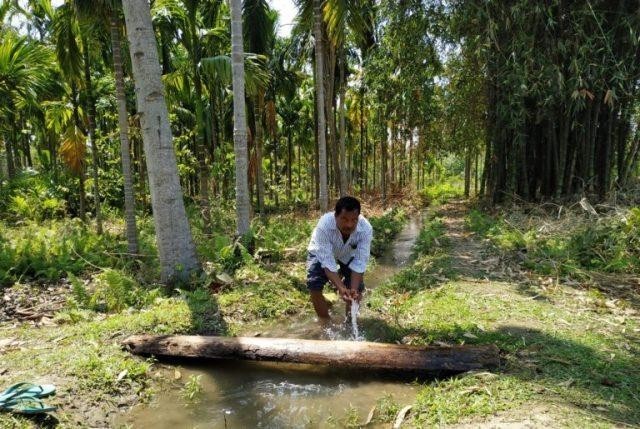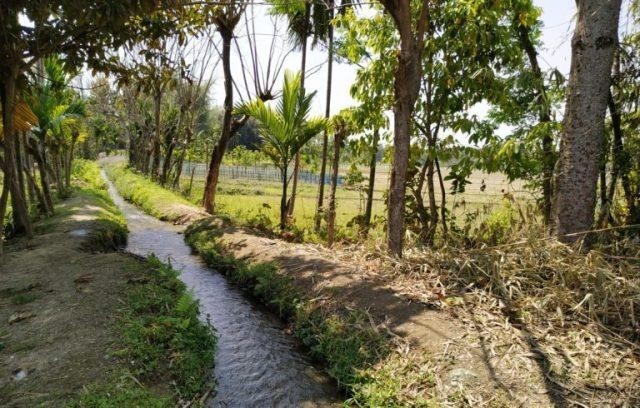Dong Traditional Water Management System Of Bodo People In Water Scarcity- Hit Assam
- Sometimes, particularly during monsoons, the day starts around 4 a.m., earlier than usual, for Rati Ranjan Mondal in Assam’s Nagrijuli village on the Indo-Bhutan border.
- Mondal wakes up, after a night of heavy rain and hurries to his paddy field to inspect the earthen dong and mend the damage, if any.
- Thankfully, for him, it’s intact. The incessant rain could have damaged the dong – a small canal that channels water from rivers in neighbouring Bhutan to the paddy fields of these villages and is also used for storage backyard ponds in village homes.
- The dong water system is a lifeline for hundreds of villages along the Indo-Bhutan border in Baksa district of Assam. Due to the lack of natural water bodies and inaccessibility of groundwater, villagers depend on this century-old traditional system of water management. Community-managed committees oversee the dong system and follow traditional principles of water management to ensure judicious distribution of the water and, more importantly, to ensure that there is no waste.
- “The dongs are part of a traditional knowledge system that we have been following since the days of our forefathers. I learned about it from my father and this is the way of life here. It’s difficult but it’s the only way to get water to our houses and paddy fields,” Mondal said.
- Rati Ranjan Mondal has been associated with the Dong Bandh committees for years and feels that without the dongs, survival is impossible.
- A dong is built by digging a canal in the earth, spanning from 3 feet to 10 feet deep depending on the topography and the distance from the point of origin at a river. A diversion-based dam is then created to divert some of the water into the dong that can stretch from anything between four kilometres to 15 kilometres and serve as many as four to five villages along its course. At various points along the dong, a form of sluice gate is built through which the water is channeled into a particular village as per its needs. Building dongs is a community effort and at least one person from each household joins in to dig the channels.
- Gravity makes water flow along the dongs that lead to agricultural fields and homesteads across villages. While the main dongs, which start at the rivers, are about 12- feet wide, smaller subsidiary dongs that branch off from the main ones are around three-feet wide. There are subsidiary dongs branching off from the main dong, which in turn have field channels or ‘jamphai’, diverting water from them. Sometimes it takes several days to dig one channel for the water from the river and it depends on the distance from the river to the particular area where the water flows.
- “Dongs are opened for a specific period for a particular village so that the residents can use the water in their paddy fields and also store the water in the ponds in their backyard.
- They are opened for one week for one village and the following week it is the turn of another village. Every household in each village is supposed to send at least one member to work voluntarily on the dong to ensure 24×7 flow of water, failing which there are penalties imposed on them,” said Mondal, who had been a president of the Oronga Akhoma Dong Bandh Committee, one of the oldest water management committees in the area. The dong managed by the Oronga Akhoma Dong Bandh committee is about 15 kilometres long and originates at the Bornodi river in Bhutan.
- Where government fails, tradition comes to the rescue “We have been living like this for centuries. We have seen our forefathers digging dongs to bring water to our area. There is no government help to make water available for us. Although, the government did try.
- Around a decade ago, the public health engineering (PHE) department tried to set up tube wells here but failed. They installed the tube wells but there was no water. We were told that the groundwater level is very deep and it’s not possible to get water here,” said Prafulla Barman, a school teacher of the area, adding: “The entire Nagrijuli area is in the plains located close to Bhutan and it is difficult to get groundwater due to hard stones beneath the ground.” According to Barman, the people of the area earlier used to pay a tax to the government of Bhutan for using water from their rivers. The system of giving tax was, however, stopped in the early 90s after an agreement between the governments of India and Bhutan, executed by the government of Assam.
- While there are at least six major community- managed dong bandh committees in the area, there are other small dong bandh committees that supervise water flow to other areas along the Indo-Bhutan border. Hundreds of thousands of families in villages located along the Indo-Bhutan border in Assam are dependent on this traditional water management system.
Due to the lack of natural water bodies and inaccessibility of groundwater, villagers depend on this century-old traditional system of water management.
- The areas along the Indo-Bhutan border remained backward for decades as they were the hotbed of insurgency during the secessionist armed movement carried out by different organisations fighting for a separate state for Bodo people. Baksa, along with Kokrajhar, Chirang and Udalguri, witnessed a series of insurgent activities between the 1980s and 2003. In 2003, the Central government signed a peace accord with one of the major insurgent outfits paving way for the creation of Bodoland Territorial Council (BTC), a territorial council under the Sixth Schedule of the Constitution of India, to ensure development as well as self- administration of the Bodo people, one of the largest plains tribes in Assam.
- While the water scarcity is still a reality in these villages, a major part of the people’s woes were addressed after non-governmental organisation Gramya Vikash Mancha(GVM) helped the dong bandh committees with modern interventions.
- According to Rathin Choudhury, another resident of the area, the situation was worse in the past when villagers spent more time repairing the earthen dongs, that were prone to damage during the monsoon, rather than working in the fields. Lots of people migrated towards other areas due to the water scarcity. “The land is fertile here but it’s of no use
- without water,” he said adding that many people have, however, returned after the GVM intervention. “In those days, women of the villages had to walk for miles to fetch drinking water during dry seasons. Water was like gold in those days. Now there is water is available in the dongs and we can spend more time in our paddy fields,” he said. The installation of sluice gates has reduced the need for labour by the villagers as the flow of water can now be controlled.
- “We have been working with the people in Baksa for the last 10 years. While we are not altering the traditional knowledge and water management system, we have tried to help them with some scientific interventions. With the help of Jamsetji Tata Trust, we built around 22 concrete structures in some areas where the dongs were prone to damage during monsoon and 10 sluice gates to help control the flow of water without human effort,” said Ansuma Brahma, project manager, GVM. “Earlier the villagers had to spend a lot of time in repairing and mending the mud dongs. Some locations were vulnerable to high water flow that caused damage. We made some concrete guard walls in these areas to ensure that the water flow of the dong is not affected even during heavy
- monsoon rains,” he said, adding that farmers can now focus on their fields, which, in turn, gets them better yield and income.
- Community water management unites people along Indo-Bhutan border This traditional water management and distribution system, run by community participation, have also been the binding factor for different religious and linguistic communities in the area.
- Although Assam had in the past witnessed severe communal clashes, there have been no major reports of any such clashes in these areas. “I have been studying the people of the area for quite some time now. There are different linguistic and religious communities in these areas. However, there are no major reports of any clashes between the communities. The water management system and the dong bandh management committees brings them together,” said social development specialist Nayan Joyoti Bhuyan, who is an executive director of Institute of Media and Development Studies and has worked as an independent researcher in the area on vulnerability assessment of rural life and livelihood.
- People of Goibari village in Assam’s Baksa district join hands to make an earthen dong to get water to flow from Bornodi river in Bhutan to their village.
- “Hindus, Muslims, Bodos, Nepalis – all of them have been living peacefully; water binds them all,” said Bhuyan


